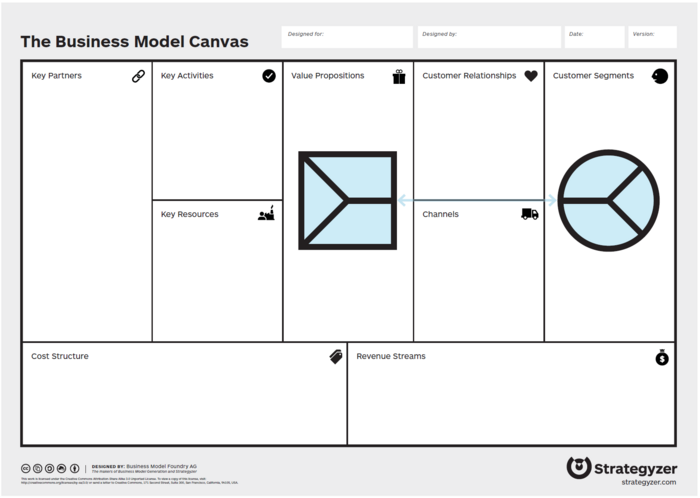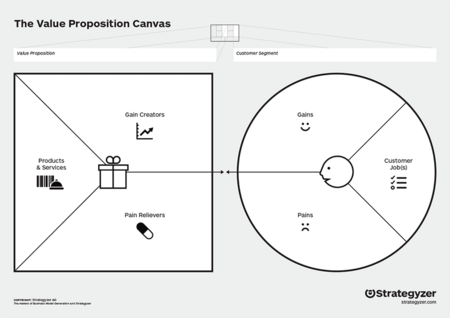Value proposition canvas
| Line 40: | Line 40: | ||
=== Value Proposition Canvas === | === Value Proposition Canvas === | ||
Alexander Osterwalder describes the Value Proposition Canvas as a 'Plug-in' to the Business Model Canvas allowing the project manager to zoom in on how to create value for the customers. <ref name=lederindsigt/>. | Alexander Osterwalder describes the Value Proposition Canvas as a 'Plug-in' to the Business Model Canvas allowing the project manager to zoom in on how to create value for the customers. <ref name=lederindsigt/>. | ||
| − | The Value Proposition Canvas looks at two parts - the value proposition map and the customer segment map. The value map describes how the project manager intends to create value, while the project manager shows their understanding of their customers in the customer profile | + | The Value Proposition Canvas looks at two parts - the value proposition map and the customer segment map. The value map describes how the project manager intends to create value, while the project manager shows their understanding of their customers in the customer profile. |
The value proposition can be split into: ''Products & Services'', ''Gain Creators'' and ''Pain Relievers''. | The value proposition can be split into: ''Products & Services'', ''Gain Creators'' and ''Pain Relievers''. | ||
| − | *'''Products & Services:''' The bundle of products and services that the organization offers their customers in order to satisfy their needs. | + | *'''Products & Services:''' The bundle of products and services that the value propositions are built on and that the organization offers their customers in order to satisfy their needs. |
*'''Gain Creators''': How the products or services benefits the customers. It describes how the project manager plans to create gains for the customer. | *'''Gain Creators''': How the products or services benefits the customers. It describes how the project manager plans to create gains for the customer. | ||
*'''Pain Relievers''': How the products or services eliminate the potential pains or annoyances the customer might have. Details how the project manager will remove pains. | *'''Pain Relievers''': How the products or services eliminate the potential pains or annoyances the customer might have. Details how the project manager will remove pains. | ||
| − | The customer map can be split into: '' | + | The customer map can be split into: ''Customer Jobs'', ''Gains'' and ''Pains'' |
| − | *'''Gains''': | + | *'''Customer jobs''': Describes the tasks that the customers try to finish, problems they try to work out or needs to satisfy. The project manager has to use the customer's perspective when analyzing the jobs. |
| − | *'''Pains''': | + | *'''Gains''': The benefits the customers wishes to see. |
| − | + | *'''Pains''': The challenges the customers face when getting a job done. The project manager must identify the pains and its severeness in order to produce pain relievers- | |
| + | When the value proposition map and customer segment map meet each other, the project manager achieves a ''fit'' <ref name = ValueDesign>Alexander Osterwalder et al., ''Value Proposition Design'', 2013.</ref><ref name = lederindsigt>Alexander Osterwalder et al., ''Value Proposition Design'', 2013.</ref> | ||
| + | |||
| + | |||
| + | |||
Revision as of 05:04, 26 February 2018
In order to provide customers with good service and valuable products, an organization should define their value propositions for their projects. In order to create successful projects a project manager must use his skills and knowledge to plan projects and create project plans to meet the project and product requirements by the customers [1]. The value propositions set by the organization for their specific products can guide the project managers to develop project plans that satisfy their customers and provide them with valuable products. The Value proposition canvas is a tool that can be used in order to solve the problems of specific customer segments and fulfill their needs by providing products and services that creates value for the customer. The organization should design value proposition with benefits in order to attract customers and make them choose one company rather than its competitors [2]. The project manager has to make sure that the value proposition and customer profile complement each other so that the customer segment is provided with the right products/service and that the customer’s pains are met with the right pain relievers [3].
This article will describe the value proposition canvas and the importance of choosing the right value proposition. The relation between project management and the canvas will be described along with how the canvas can be used to satisfy customers and stakeholders.
Contents |
Description
Project management is using tools, skills and knowledge in order to meet project requirements and can be done through project management processes [4]. In project management a project manager must use his skills and tools in order to meet project requirements as well as the wants of customers/stakeholders. Project management can be categorized into five process groups: Initiating, Planning, Executing, Controlling and Closing. In the initiating process group the scope of a project and stakeholders/customers are identified. The needs and expectations of the stakeholders are identified. A project manager must communicate with stakeholders in order to analyze their needs and concerns [1].. The project manager can use the Value Proposition Canvas as a tool to understand and analyze the stakeholders.
Identifying and choosing the value propositions are an important part of creating value for the customers and stakeholders. However, it is not enough to only design the value propositions, it is also important to integrate a business model in order to create value for the organization. The Business Model Canvas can be used for this purpose. [2].
Business Model Canvas
[2]. A business model is game plan for implementing strategies through organizational processes and systems. The Business Model Canvas consists of 9 building blocks and can be used as a tool to describe how an organization creates and delivers value. To quickly sum up the Business Model Canvas:
- Customer Segments: Group or people that the organization wants to create value for with value propositions
- Value Propositions: Products or services that creates value for a particular customer segment
- Channels: How value propositions are delivered to a customer segment
- Customer Relationships: Establishment of relationship with particular customer segments
- Revenue Streams: Result from successfully delivered value propositions to customer segments
- Key Resources: Required assets to provide the elements described above.
- Key Activities: Important activities that the company must execute well.
- Key Partnerships: External suppliers and partners
- Cost Structure: Cost to meet a business model
The left side of the Business Model Canvas concerns the organization (internal), while the right side concerns the customers (external). Both the internal and external forces meet around the value propositions. In the Value Proposition Canvas the two blocks Customer Segments and Value Propositions are used to describe how the organization creates and exchanges value with the customers/stakeholders[2].

Value Proposition Canvas
Alexander Osterwalder describes the Value Proposition Canvas as a 'Plug-in' to the Business Model Canvas allowing the project manager to zoom in on how to create value for the customers. [3]. The Value Proposition Canvas looks at two parts - the value proposition map and the customer segment map. The value map describes how the project manager intends to create value, while the project manager shows their understanding of their customers in the customer profile.
The value proposition can be split into: Products & Services, Gain Creators and Pain Relievers.
- Products & Services: The bundle of products and services that the value propositions are built on and that the organization offers their customers in order to satisfy their needs.
- Gain Creators: How the products or services benefits the customers. It describes how the project manager plans to create gains for the customer.
- Pain Relievers: How the products or services eliminate the potential pains or annoyances the customer might have. Details how the project manager will remove pains.
The customer map can be split into: Customer Jobs, Gains and Pains
- Customer jobs: Describes the tasks that the customers try to finish, problems they try to work out or needs to satisfy. The project manager has to use the customer's perspective when analyzing the jobs.
- Gains: The benefits the customers wishes to see.
- Pains: The challenges the customers face when getting a job done. The project manager must identify the pains and its severeness in order to produce pain relievers-
When the value proposition map and customer segment map meet each other, the project manager achieves a fit [5][3]

Application
Application
Common Mistakes
Example: Tesla
Further Reading
Alexander Osterwalder & Yves Pigneur: Business Model Generation, 2010
- Learn about the Business Model Canvas to learn about creating value and improving organizations. The book describes how to use business model in order to position an organization in a competitive advantage and re-designing an organization's business models.
Alexander Osterwalder et al.: Value Proposition Design, 2013
- Learn about creating desirable products for customers and the processes and tools in order to create and sell the products.
Office Of Government Commerce: A Guide to the Project Management Body of Knowledge (PMBOK® Guide), 2013
- Learn about fundamental practices that drives businesses and that reflects the current industry knowledge and practises.
References
- ↑ 1.0 1.1 Office Of Government Commerce, A Guide to the Project Management Body of Knowledge (PMBOK® Guide), 5th Edition, 2013
- ↑ 2.0 2.1 2.2 2.3 Osterwalder, Alexander and Pigneur, Yves, Business Model Generation, 2010.
- ↑ 3.0 3.1 3.2 https://lederindsigt.dk/vaerktoejer-skabeloner/strategi-og-forretningsudvikling/value-proposition-canvas/
- ↑ https://sd-ds-dk.proxy.findit.dtu.dk/Viewer/Standard?ProjectNr=M268368&Status=90.20&VariantID=46&Page=0
- ↑ 5.0 5.1 Alexander Osterwalder et al., Value Proposition Design, 2013.
- ↑ https://strategyzer.com/canvas/value-proposition-canvas/